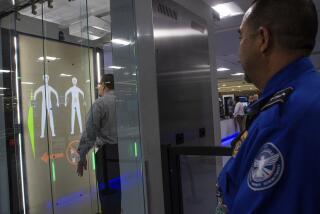Info on TSA wait-time apps is usually off. A new real-time tracking tool changes that
- Share via
That TSA wait-time app you’re using to estimate how long it will take you to get through airport security? It doesn’t measure what you think it does. Apps, even the one developed by the TSA, rely on crowdsourcing and historical data rather than real-time numbers. A new tracking tool is changing all that.
“There are several trials out there that let you track the real wait times at airports,” said Bayram Annakov, a frequent flier and chief executive of App in the Air. “But there hasn’t been anything that I have found feasible yet.”
There’s no guarantee you’ll get TSA PreCheck, which speeds you through the airport security. Here are some of the reasons it may not be happening for you.
For the record:
10:53 a.m. Sept. 4, 2019A prior version of this story called the new tech tool BlipTrack. The Danish-based company Veobo updated the name to Passenger Predictability Solutions.
Veovo, a Denmark-based company, created a tool called Passenger Predictability Solutions (formerly BlipTrack) that uses sensors to pick up Wi-Fi and Bluetooth signals from electronic devices every time a traveler enters and exits the security checkpoint. Travelers don’t have to consult an app to get the information; it’s displayed in monitors across the airport.
Four New York-area airports, including JFK and La Guardia, are using BlipTrack. The most recent airport to adopt the real-time data is the one that serves Cincinnati.
“It’ll be in everybody’s best interest if TSA at airports across the country use this technology to collect the data and share it with us and other companies so we can better serve our users,” Annakov said.
As airline passenger numbers break records, LAX and several other major U.S. airports have reduced security checkpoint wait times.
To be fair, apps such as Miflight, Flightspeak, App in the Air and even the MyTSA app provide lots of information besides wait times. To predict how long you’ll be in line, those apps rely on travelers posting their individual wait times and historical wait times. The problem: Predictions are based on past patterns or unverified info, or a combination of both. Moreover, crowdsourced apps work only if travelers stop and post the status of their line.
Annakov said fliers might get a more accurate wait-time estimate by checking multiple apps. “Just combining information from different apps and averaging the estimates will give you a more accurate picture on the wait time.”
Why do wait times matter? Because more of us are flying. Airports across the country are experiencing the heaviest travel volume ever recorded, said TSA spokeswoman Dani Bennett. TSA’s busiest day in history was July 7, when it screened 2.8 million passengers and crew members, surpassing the Memorial Day weekend record by about 2,000.
Although security check lines may seem long when you’re in them, a recent L.A. Times story reported that average wait times at airports across the country have declined. The wait time at LAX dropped to less than six minutes, the story said. For travelers short on time, accurate TSA wait times could help avoid a frantic race to the gate.
The Port Authority of New York and New Jersey, which oversees airports in the area, partnered with the TSA and other agencies to install the new tech tool earlier this year.
So why aren’t apps using real-time data? Largely because they aren’t allowed to collect the data without the permission of the airport.
More to Read
Sign up for The Wild
We’ll help you find the best places to hike, bike and run, as well as the perfect silent spots for meditation and yoga.
You may occasionally receive promotional content from the Los Angeles Times.








